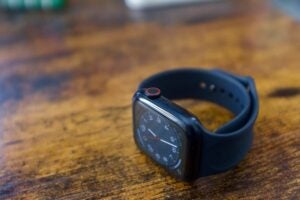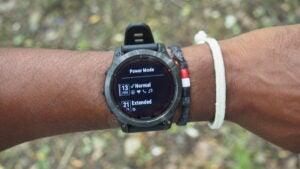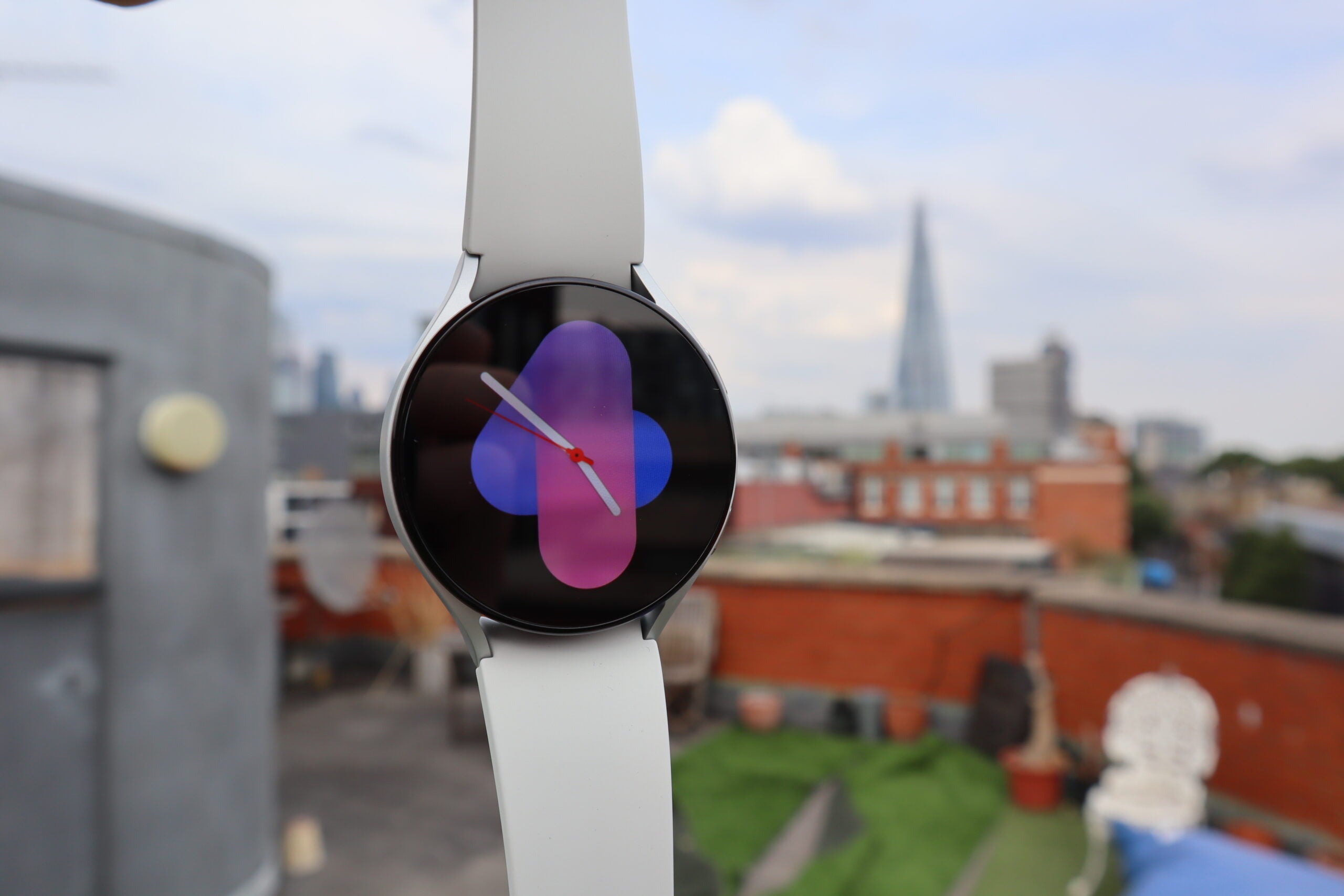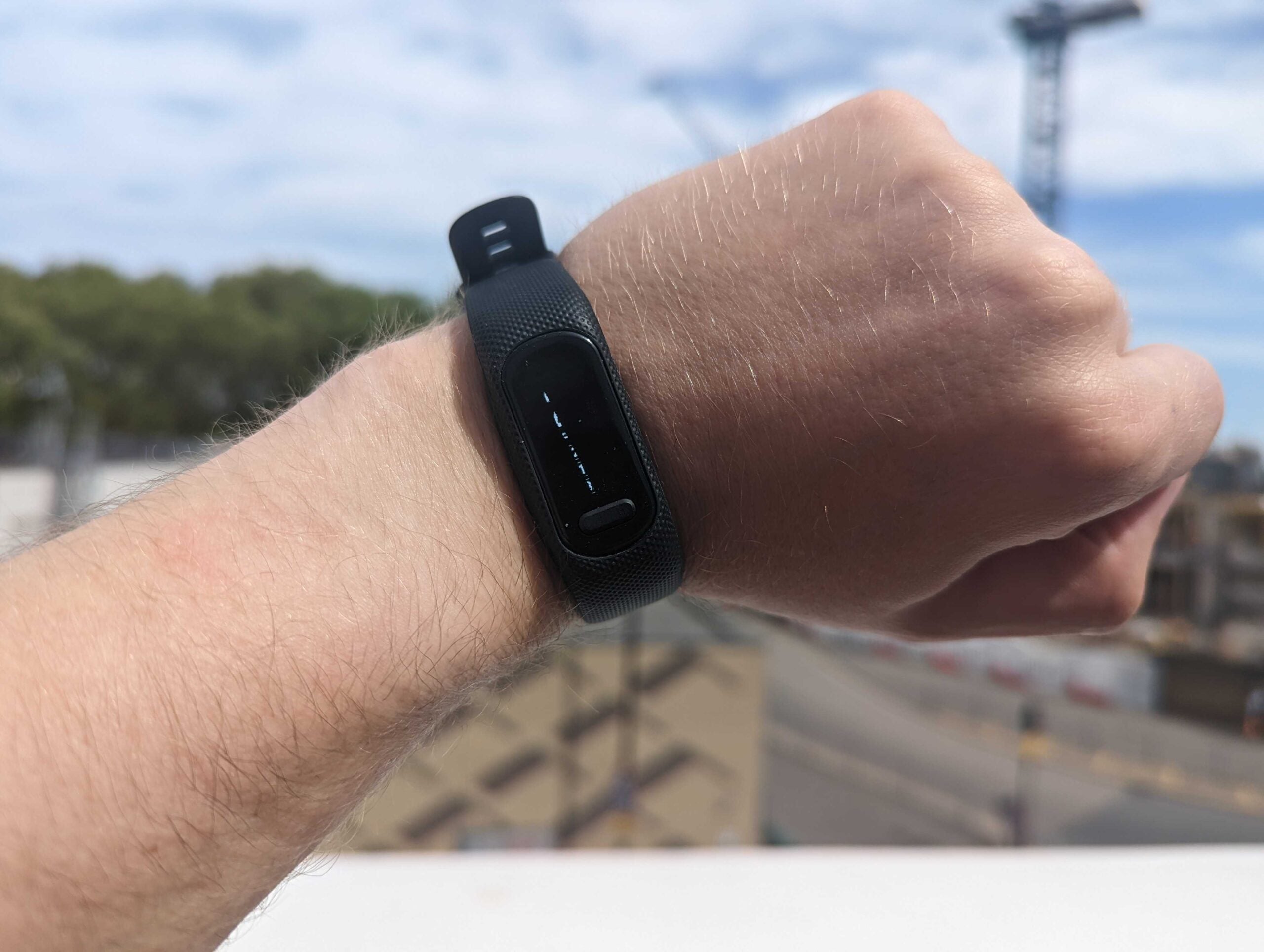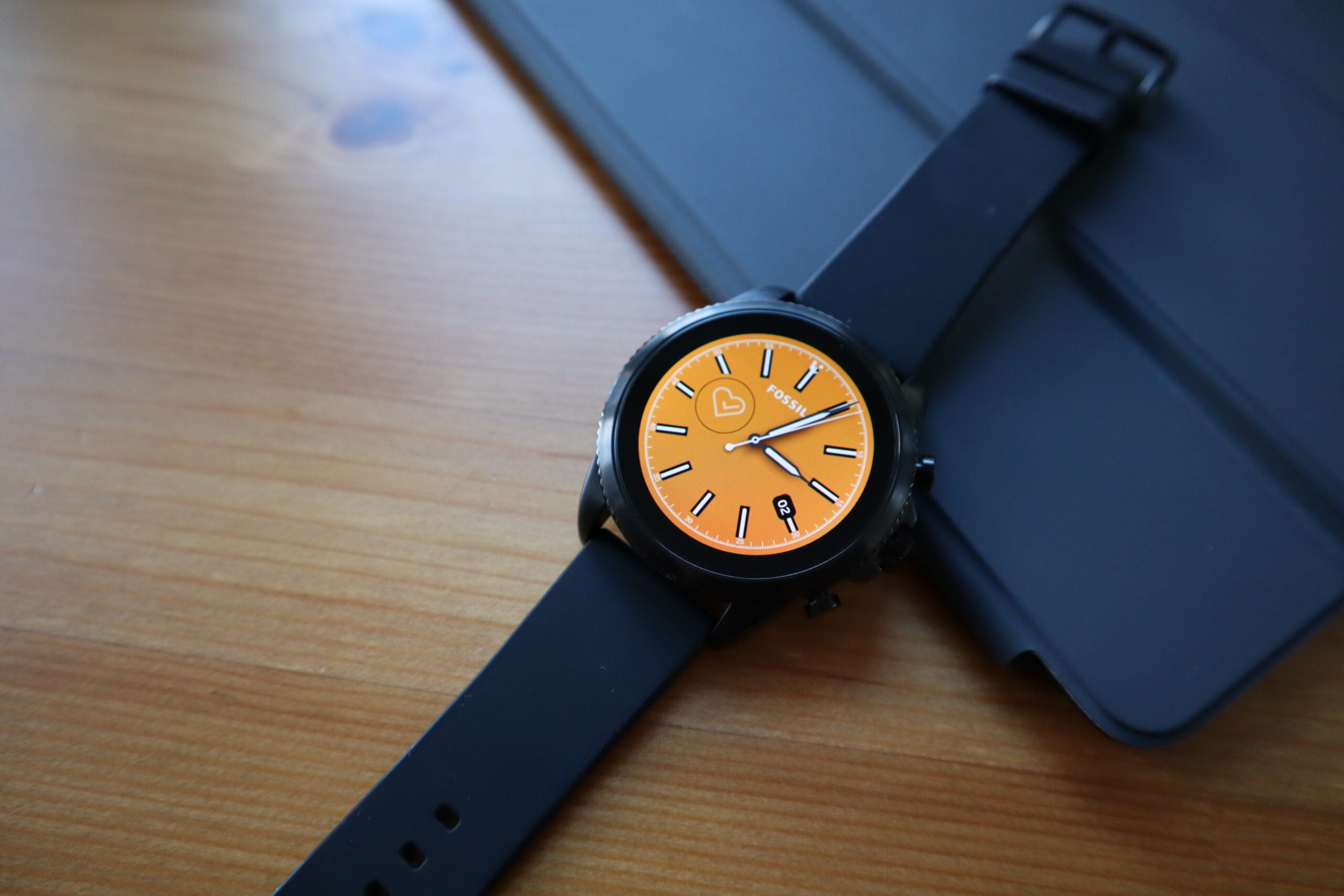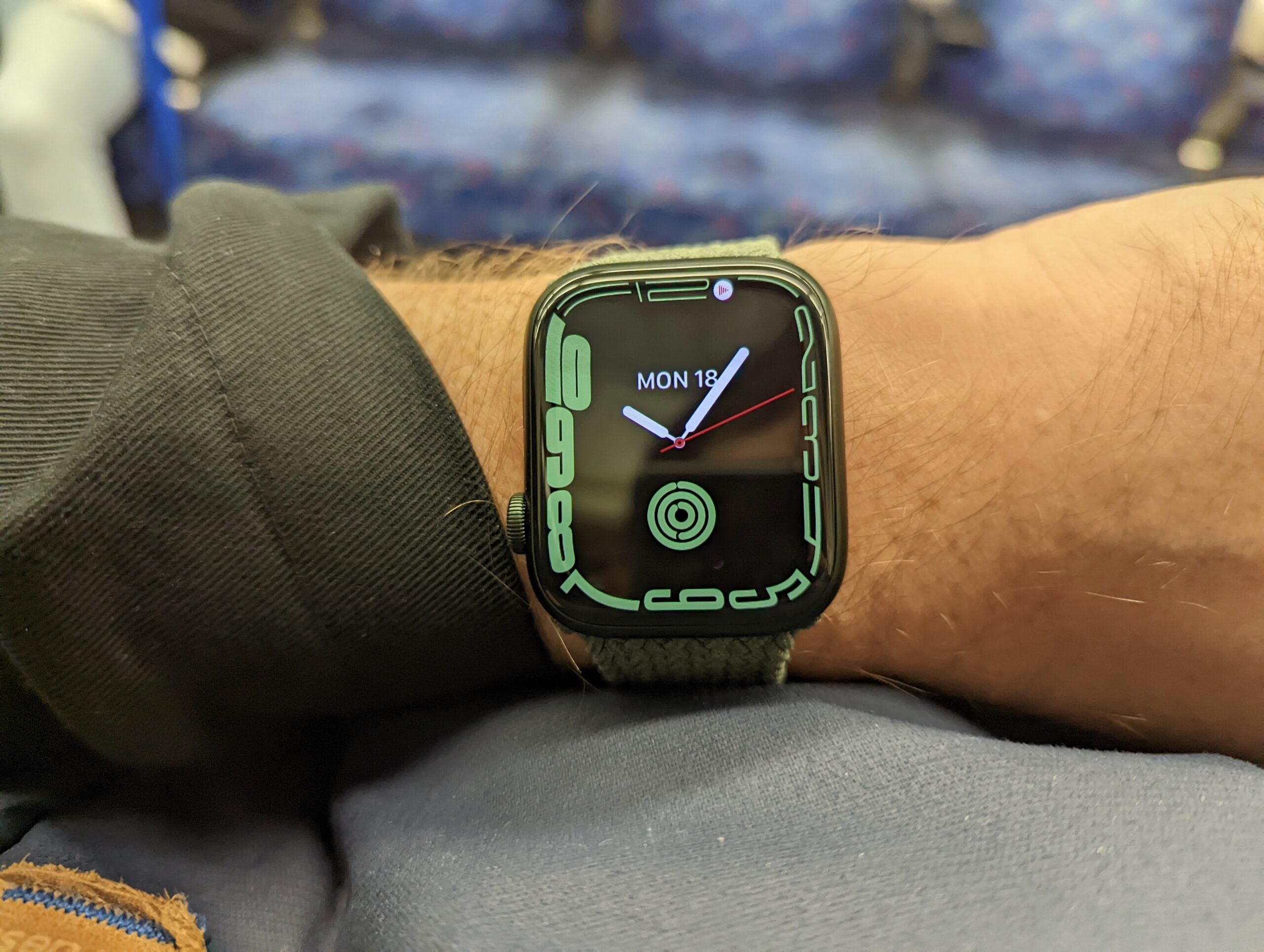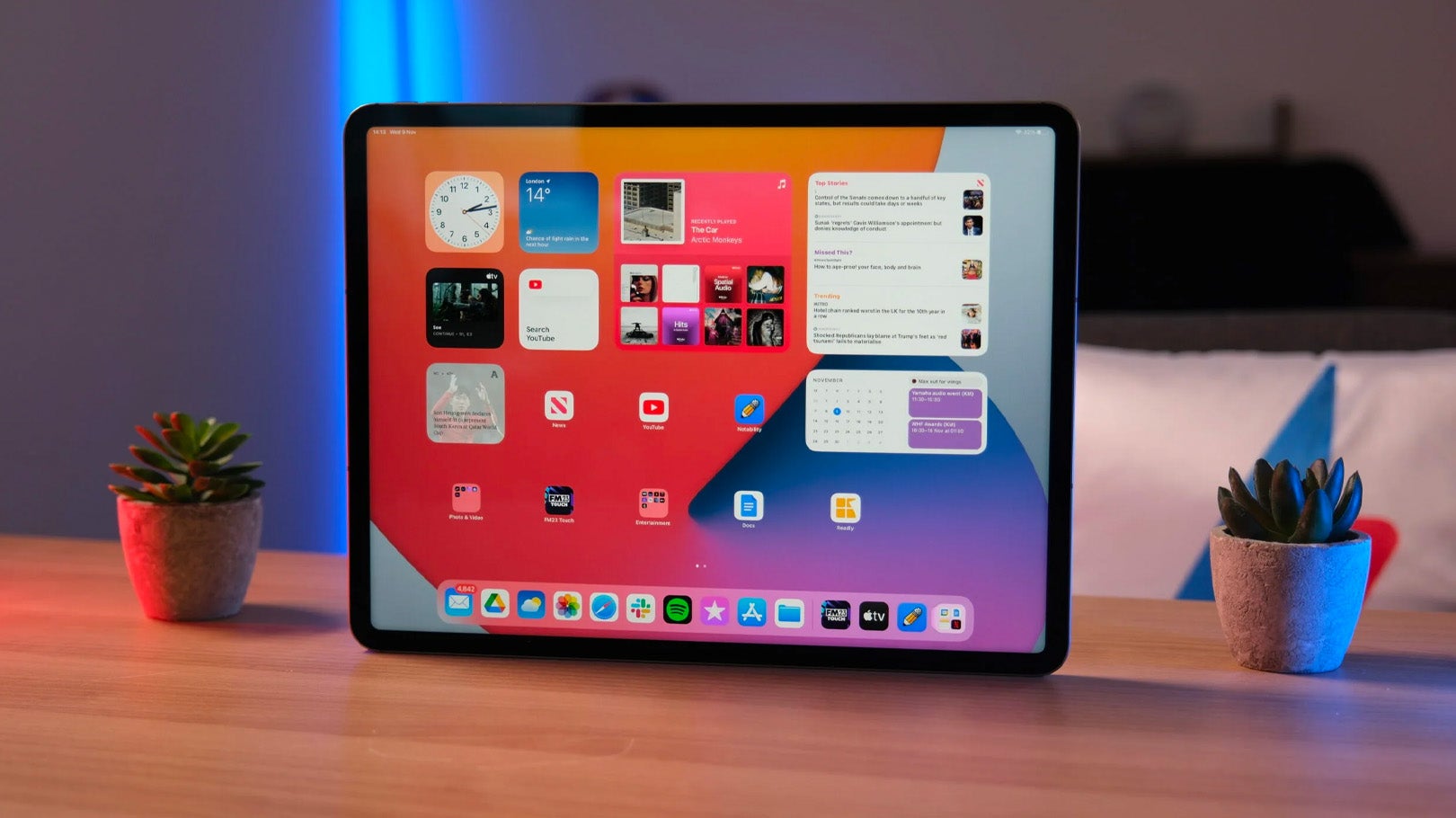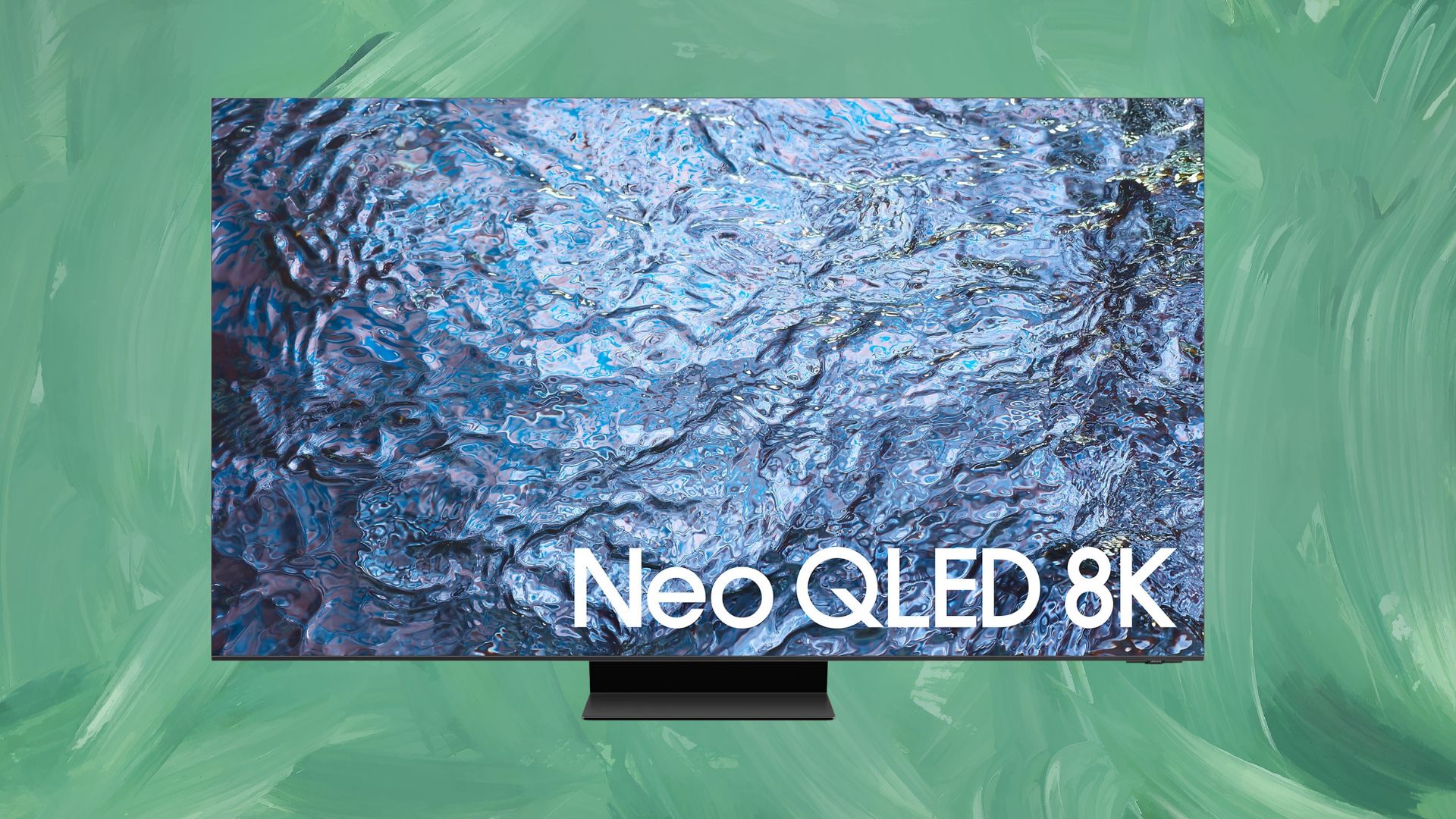Best Smartwatch 2024: The top wearables we’ve tested

There has never been a better time to buy a smartwatch, with wearables available in all kinds of shapes and sizes at a variety of price points.
From the humble beginnings of Pebble, where smartwatches were essentially just wrist-worn pagers, the market has blossomed. Fast forward to 2024 and there’s a broad range of feature-packed wearables to choose from, each with a different focus. Whether you’re looking for a wearable to check your notifications and control your music or you’re a hardcore triathlete in need of a serious training companion, there’s a smartwatch that’ll suit your needs.
But while the wide selection of wearables is great for choice, it can also make the decision of which to buy a difficult one. With so many wearables focusing on specific types of user and the market, and many still costing a fair amount of cash, how can you be sure that you’re getting the right smartwatch for your needs?
You’ve also got elements like compatibility to consider. Apple Watches, for example, only work when paired with an iPhone, making them a poor investment for Android users. Android users aren’t safe either; the Samsung Galaxy Watch 6 and 6 Classic will work on any Android, but only Samsung phone users will be able to access the whole suite of features.
There’s also the issue of seemingly-strong smartwatches not performing well in the real world, offering terrible battery life and poor build quality, despite having decent specs sheets.
That’s where the expert team at Trusted Reviews comes in. We’re here to help you avoid these pitfalls and help you find the right smartwatch for your specific needs and budget with our hand-picked selection of the very best smartwatches available in 2024.
Every wearable in our list has been used by the reviewer for at least a week, during which time they test just about every element of the smartwatch, from tracking accuracy to battery life, ease of use and build quality, so you can trust that our advice is solid.
If you don’t find exactly what you’re looking for here you can also check out our more specific best fitness tracker, best Apple Watch and best running watch guides, which go into more detail for those specific categories. We’ve even got a guide to the best Samsung Galaxy Watch for Samsung fans.
At a glance
- Best smartwatch: Apple Watch Series 9 – check price
- Best value smartwatch: Apple Watch SE 2 – check price
- Best Wear OS smartwatch: TicWatch Pro 5 – check price
- Best for serious athletes: Garmin Fenix 7 Pro – check price
- Best hybrid smartwatch: Garmin Vivomove Trend – check price
- Best for entry-level fitness tracking: Fitbit Versa 3 – check price
- Best Samsung smartwatch: Samsung Galaxy Watch 5 Pro – check price
- Best rugged smartwatch: Apple Watch Ultra 2 – check price
- Best for battery life: Coros Vertix 2 – check price
How we test
Every smartwatch we test is used by the reviewer for at least a week, or longer if the battery life lasts beyond that point or we need more time to trial its features.
During testing we will check it for key metrics including app support, usability and battery life. If the device offers fitness, location or health tracking features we will also test these for accuracy and reliability.
For distance tracking we record how accurately the device recorded runs on tracks we know the length of. We also record how much battery is lost using things like in-built or connected GPS per hour. To check heart rate accuracy we compare the results recorded on the wearable to a dedicated HRM strap.
After recording the data we then pair it with our general experience using the wearable day-to-day, letting you know if it’s comfortable to wear or if we encountered unexpected bugs during use over the review period.
- Certain models made from recycled aluminium
- Faster Siri
- Accurate tracking
- Very bright screen
- Design remains the same
- Health data needs to be shown better
- Plenty of the best Apple Watch features in a cheaper package
- Excellent software
- Wide customisation options
- Accurate tracking
- Slow charging
- No always-on display
- Outstanding battery life
- Wear OS 3 is finally on a TicWatch
- Fast charging
- The secondary FSTN display is always welcome
- Not the most stylish of smartwatches
- Included watch faces are hit and miss
- No Google Assistant
- Still great battery life
- Added map features
- Solid sports tracking
- Not a hugely different experience from the Fenix 7
- Heart rate sensor doesn’t offer radical improvements
- Improved MIP display just a touch brighter and clearer
- Great look
- Well integrated digital display
- Impressive array of fitness and wellness features
- Handy wireless charging
- Fiddly to get to some sub-menus
- Not your typical big Garmin battery life
- Higher quality displays on other Vivomove watches
- Not much cheaper than Vivomove Style
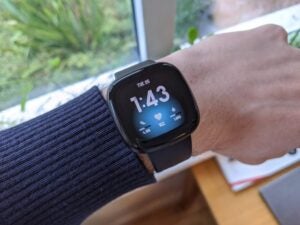 Best for entry-level fitness tracking
Best for entry-level fitness tracking
- Feature-packed for the price
- GPS is finally here
- Six-day battery with intensive use
- Fitbit’s apps and app store still need work
- The step count is just too eager
- Still no support for offline Spotify
- Fitbit Premium is essential for getting your money’s worth
 Best WearOS Watch
Best WearOS Watch
- Solid fitness tracking services
- Rugged, sports-ready design
- Wonderfully bright display
- Route planning process feels clunky
- Battery life doesn’t match rival fitness trackers
- Top screen
- Excellent sports tracking
- The best Apple Watch
- Fitness tracking feels dated
- Lack of performance analysis
- Mapping rolling out slowly
- Great battery life
- Reliable sports tracking
- Added map support
- Music player doesn’t work with third-party apps
- Heavier than original Vertix
- Missing ANT+ support

Apple Watch Series 9
The best smartwatch
Pros
- Certain models made from recycled aluminium
- Faster Siri
- Accurate tracking
- Very bright screen
Cons
- Design remains the same
- Health data needs to be shown better
It should come as no surprise that the Apple Watch Series 9 has our current top slot as the best smartwatch of 2024 given that its predecessors also managed to dominate the competition in their respective launch cycles, and while there’s no denying that Apple’s wearable is probably overdue a design refresh, it continues to exemplify the very best of smartwatch tech.
At its core, the Apple Watch Series 9 benefits from Apple’s outstanding watchOS software. Although competition is certainly starting to heat up from Google and its current Wear OS 4 platform, Apple has invested far more time and effort over the years to build up the watchOS ecosystem to the point where everything just works.
Watch faces are colourful and plentiful (including a number of branded ones featuring Disney characters and even Snoopy himself), the new Smart Stack shows key bit of information quickly, and there’s an abundance of third-party apps to make the Apple Watch Series 9 feel like a proper extension of your iPhone.
In terms of upgrades over the Apple Watch 8, the Watch 9 doesn’t exactly rock the boat, and if you do have the former then it’s probably best to wait for a few more generational updates before taking the leap, but there are still a few things of note.
For starters, the screen is now incredibly bright, with a peak brightness of 1000 nits, the same cap from the original Apple Watch Ultra. Not only does this make the torch feature more functional than ever before, but it also makes the Apple Watch much easier to read in direct sunlight.
The new Double Tap feature is also handy in a pinch (pardon the pun), as it allows you to interact with the watch just by tapping your thumb and forefinger together. While the feature isn’t a game changer, it does have its uses as it means you can stop timers and pick up calls during moments where your hands are occupied like when you might be carrying some shopping.
Reviewer: Max Parker
Full review: Apple Watch Series 9 Review
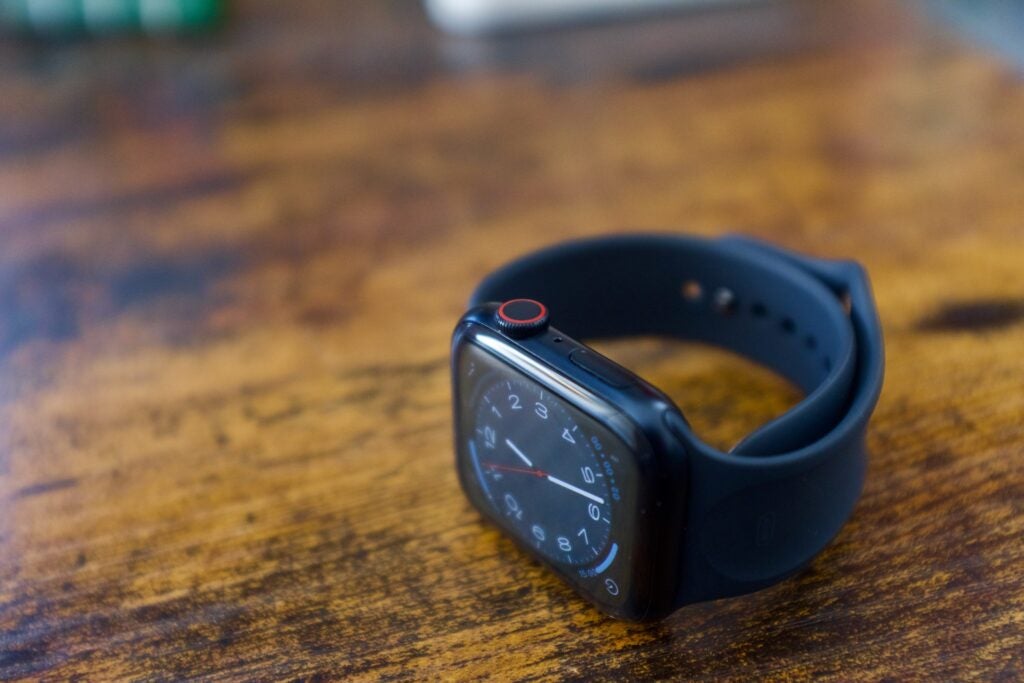
Apple Watch SE 2
The best value Apple Watch
Pros
- Plenty of the best Apple Watch features in a cheaper package
- Excellent software
- Wide customisation options
- Accurate tracking
Cons
- Slow charging
- No always-on display
The original Apple Watch SE was a great prospect for consumers, offering up the core watchOS experience at a significantly lower price than the mainline numbered Apple Watches. The Watch SE 2 continues that trend but this time it’s implemented a few of the latest high-end features whilst also bringing the price down slightly.
The biggest upgrade for the SE 2 is the included S8 chipset, which is the exact same processor found within the far pricier Apple Watch 8. This means that you’re getting the same speedy performance of Apple’s latest wearable, so when it comes to day to day use, you’re not penalised by opting for the cheaper watch.
Also added to the SE 2 is Apple’s new accelerometer which allows the watch to detect if you’ve been in a car accident before calling the local authorities. Of course it’s the type of feature that hopefully you should never have to put to the test, but it does give some peace of mind to know that it’s there.
Of course, the caveats with the original Watch SE remain, including the lack of an always-on display and the absence of both the ECG monitor and the blood oxygen sensor. If you feel that any of those features are ones that you can’t live without then it’s worth plumping to get one of the mainline Apple Watches.
Still, even without those additional sensors, workout tracking on the Watch SE 2 is top notch, particularly for how seamlessly it syncs with the iPhone fitness app so you know exactly whether or not you’ve been hitting your fitness goals. There’s even built-in GPS tracking and support for offline playback via Apple Music.
It’s not worth upgrading to if you have the original Apple Watch SE, but if you’re looking for your first Apple wearable and you don’t want to spend too much money in the process, then there’s a lot to love about the Apple Watch SE 2.
Reviewer: Max Parker
Full review: Apple Watch SE 2 Review
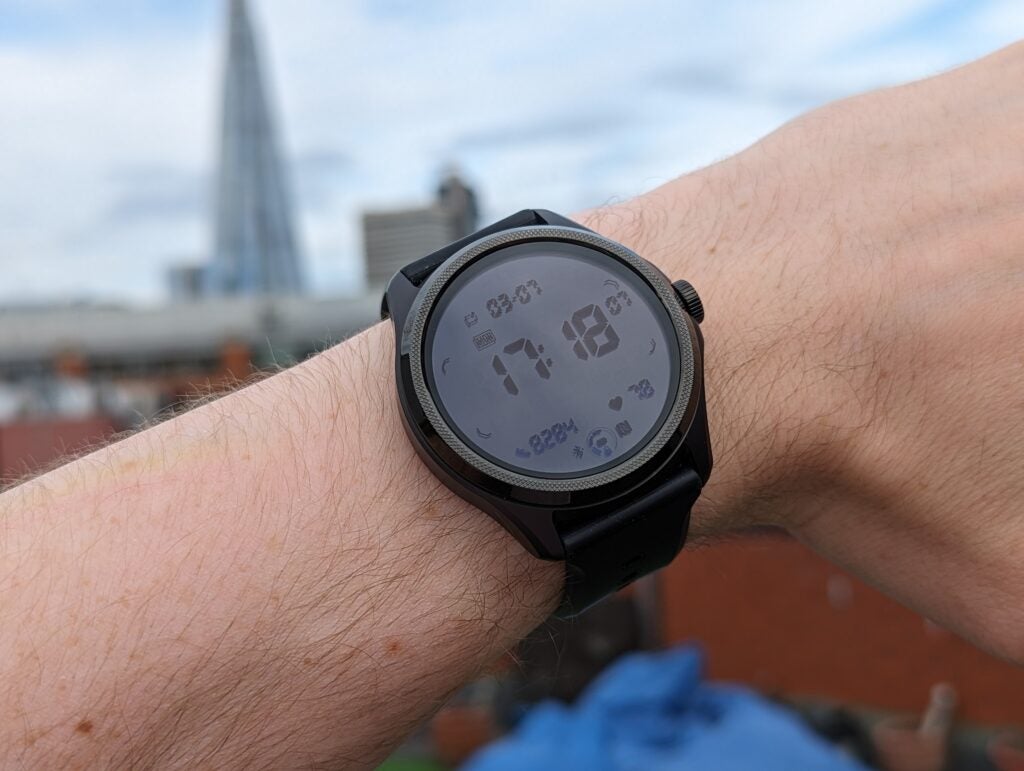
TicWatch Pro 5
Best Wear OS smartwatch
Pros
- Outstanding battery life
- Wear OS 3 is finally on a TicWatch
- Fast charging
- The secondary FSTN display is always welcome
Cons
- Not the most stylish of smartwatches
- Included watch faces are hit and miss
- No Google Assistant
Mobvoi is one of the longest-running proponents of Wear OS, and while the company has had some hits and quite a handful of misses, it finally managed to stick the landing with the TicWatch Pro 5.
For starters, the TicWatch Pro 5 is the first of Mobvoi’s smartwatches to boast Wear OS 3 at launch and the whole experience feels like a true step up from what the company has previously put out. The UI looks a lot sleeker than usual, and that’s helped by the new Snapdragon W5 Plus Gen 1 chipset, that keeps things ticking along just as you’d hope in day to day use.
What really helps the TicWatch to stand out (particularly against the Pixel Watch) is its phenomenal battery life. Under the right circumstances, it’s entirely possible for the Pro 5 to get from Monday to Friday on a single charge which just absolutely decimates the competition in this area. Even the latest Samsung watches struggle to get past two-days of use.
You don’t even have to wait too long for the Pro 5 to charge either, as we were able to get from 15% to a full battery in just slightly over an hour. If you are in a rush however, you can get a pretty significant chunk of battery back quickly. Just 32-minutes of charging got us from that 15% level to 79%.
Part of what helps to keep the battery going is the return of TicWatch’s secondary FSTN display which sits above the main panel and is able to convey key information like your step count, heart rate and the time of day in a low power state. Plus, it can now also flash a particular colour during a workout to indicate your heart rate zone without needing to wake up the watch.
The only major thing holding the TicWatch back is its lacklustre design, which doesn’t really pop in the same way as the Pixel Watch or the Galaxy Watch 5. Still, if you’re not too fussed about how it looks then you’ll find one of the best Wear OS experiences out there in the TicWatch Pro 5.
Reviewer: Thomas Deehan
Full review: TicWatch Pro 5 Review

Garmin Fenix 7 Pro
Best for serious athletes
Pros
- Still great battery life
- Added map features
- Solid sports tracking
Cons
- Not a hugely different experience from the Fenix 7
- Heart rate sensor doesn’t offer radical improvements
- Improved MIP display just a touch brighter and clearer
It’s probably best to say right off the bat that if you have a Garmin Fenix 7 then there’s no need to immediately go out and upgrade to the newer Fenix 7 Pro. The reason being that the upgrades here are relatively small, but if you’re looking to buy your first high-end Garmin watch, or even just invest in a proper running watch to hit your fitness goals, then the Garmin Fenix 7 Pro is easily one of the company’s best.
The 7 Pro builds upon the excellent foundations laid by the Fenix 7 by packing a great battery life from the jump. In smartwatch mode, it’s possible for some users to reach up to 22-days of use from a single charge, which easily outpaces the majority of smartwatches on this list. For all you marathon runners out there, you can squeeze up to 23-hours of battery in GPS mode, which is well worth doing for the excellent map data featured on the Fenix 7 Pro.
This time around Garmin has added relief shading to present maps in greater detail than before, as well as the new ‘Up Ahead’ function that provides runners with insights about any points of interest they may come across during a run or a hike. Having these features, on top of the map support that Garmin’s been refining for years now, shows why the company is the go-to pick for serious athletes.
In addition to the improved mapping, Garmin has added a new heart rate sensor which, in theory, should produce more accurate results than before. In testing however, we struggled to see any noticeable difference with the newer sensor, so if you want the most accurate data possible then we still recommend grabbing a chest-worn heart rate strap.
Overall it doesn’t boast the amount of upgrades that Garmin Fenix fans were probably hoping for, but that doesn’t mean that the Fenix 7 Pro isn’t still a great watch for fitness enthusiasts, and unless you want a few more smartwatch features from the more expensive Garmin Epix Pro (Gen 2), then you’ll get on well with what’s on offer here.
Reviewer: Michael Sawh
Full review: Garmin Fenix 7 Pro Review
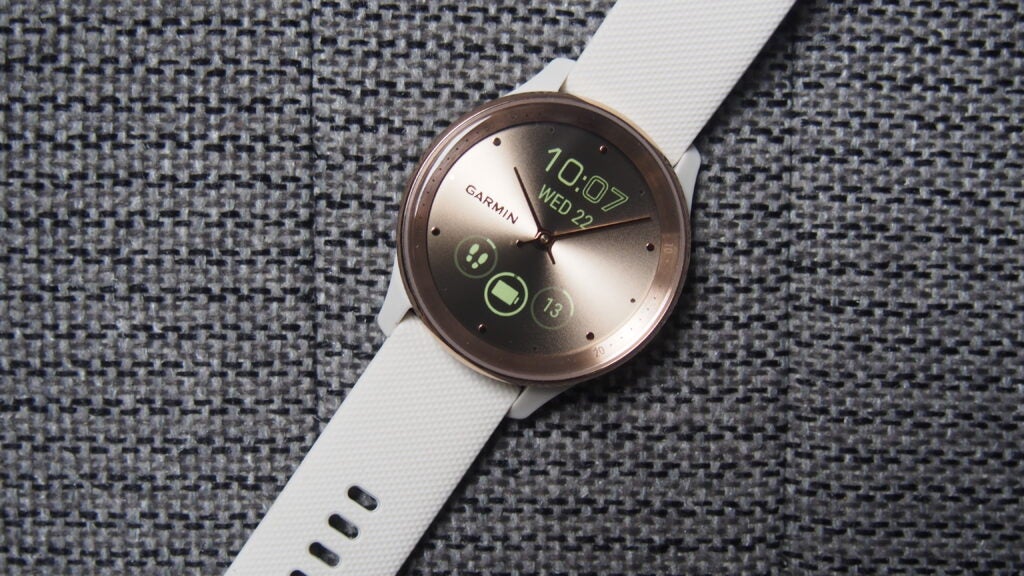
Garmin Vivomove Trend
Best hybrid smartwatch
Pros
- Great look
- Well integrated digital display
- Impressive array of fitness and wellness features
- Handy wireless charging
Cons
- Fiddly to get to some sub-menus
- Not your typical big Garmin battery life
- Higher quality displays on other Vivomove watches
- Not much cheaper than Vivomove Style
The Garmin Vivomove Trend has a fantastic design, offering a combination of an analogue case and a traditional watch-faced design with a discreetly hidden display. It can be found in four colours, Cream Fold, Slate, Peach Gold and Silver, giving customers plenty of choice when it comes to styling.
The hidden display sits at 1.01 inches with a 254×256 resolution, meaning that you will be missing out on the OLED and AMOLED displays on watches like the Samsung Galaxy Watch 5 Pro. We still found it to be fine for general use indoors, although we did need to adjust the brightness to be higher when used on particularly sunny days.
Like all Garmin watches, it is waterproof up to 50 metres, meaning that you can keep it on while showering or swimming without needing to worry about damage. If you’re looking for a smartwatch for diving or other intensive underwater activities, you will want to invest in a device like the Apple Watch Ultra, which has an underwater rating of 100 metres.
The Vivomove Trend puts its focus on being a health, wellness and fitness tracker, and it definitely thrives in that area. There is an optical heart rate monitor as well as a Pulse Ox sensor onboard, with an accelerometer to track movement and detect when you’re asleep. We were able to view our daily step goals easily, with prompts popping up if you’ve been sat down for too long.
The heart rate monitor was effective, capturing a reliable resting rate and picking out any high heart reading rates from that day. You can even track your stress through heart rate variability measurements and respiration tracking; ideal for those who like to use real-life stats to keep an eye on their wellness.
The main downfall of the Vivomove Trend is that you can find other more capable watches, like the Vivomove Style, for a little more money. If you’re interested in a stylish smartwatch that offers up fantastic wellness and health insights, the Vivomove Trend is a very easy recommendation.
Reviewer: Michael Sawh
Full Review: Garmin Vivomove Trend
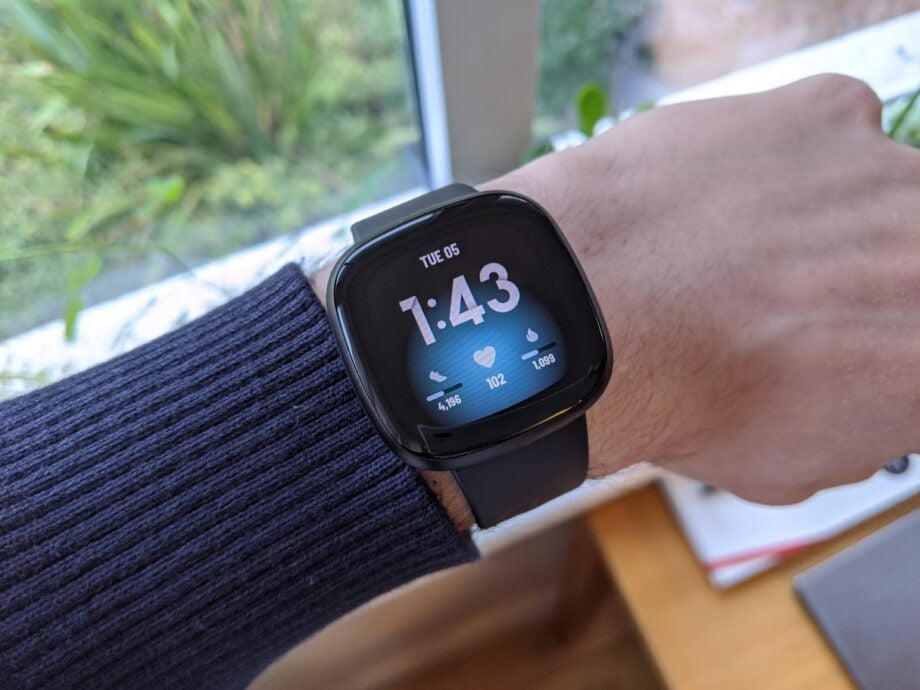
Fitbit Versa 3
The best affordable fitness tracker
Pros
- Feature-packed for the price
- GPS is finally here
- Six-day battery with intensive use
Cons
- Fitbit’s apps and app store still need work
- The step count is just too eager
- Still no support for offline Spotify
- Fitbit Premium is essential for getting your money’s worth
Fitbit is a household brand when it comes to health and fitness tracking and the Versa 3 is the best option for casual users looking for a fitness tracker with basic smartwatch functionality, based on our experience using it.
We were impressed how many features Fitbit managed to cram into the tiny square chassis, despite the Versa 3 costing nearly a third of the Garmin Fenix 7.
For starters, the watch is incredibly comfortable to wear, even when exercising. The slim, almost Apple Watch SE sized frame gives it a fashionable and discrete look that let our reviewer comfortably wear it while out of the gym, and at smart casual work events. Based on our experience, it’s only up close that most people will notice it’s not an Apple Watch, due to the slightly larger bezel surrounding the screen.
Despite its low cost the wearable does have a few pluses we’ve not seen on many other wearables at this price. For starters, there’s an inbuilt GPS chip and SpO2 sensor. These let the watch offer reliable fitness tracking without the need to lug your phone along, as you have to on many other affordable wearables, such as the Garmin Vivosmart 5 we reviewed earlier this month. The SpO2 sensor also lets it track your blood oxygen to gauge performance improvements.
With real-world use both performed admirably. The GPS does take longer than the Fenix to connect, but once it did the tracking was uniform. The only time our reviewer experienced any dropouts was during city runs and cycles, where tall buildings would on occasion block the signal. Heart rate tracking remained uniform outside of our HIIT test, where it struggled to keep up with the rapid spikes during high-intensity segments of the workout.
During testing, Spotify still wasn’t on the app store, though you could download music to play from Deezer and Pandora locally. The ability to store any music locally is again a rare luxury on a tracker this price so the absence of Spotify is forgivable.
The only real downsides are that its app offering is behind Apple and Google’s and Fitbit, unlike Garmin, asks you to pay a subscription to access all the post-workout analytics the Versa 3 offers, which feels a bit cheeky.
Reviewer: Thomas Deehan
Full review: Fitbit Versa 3 Review
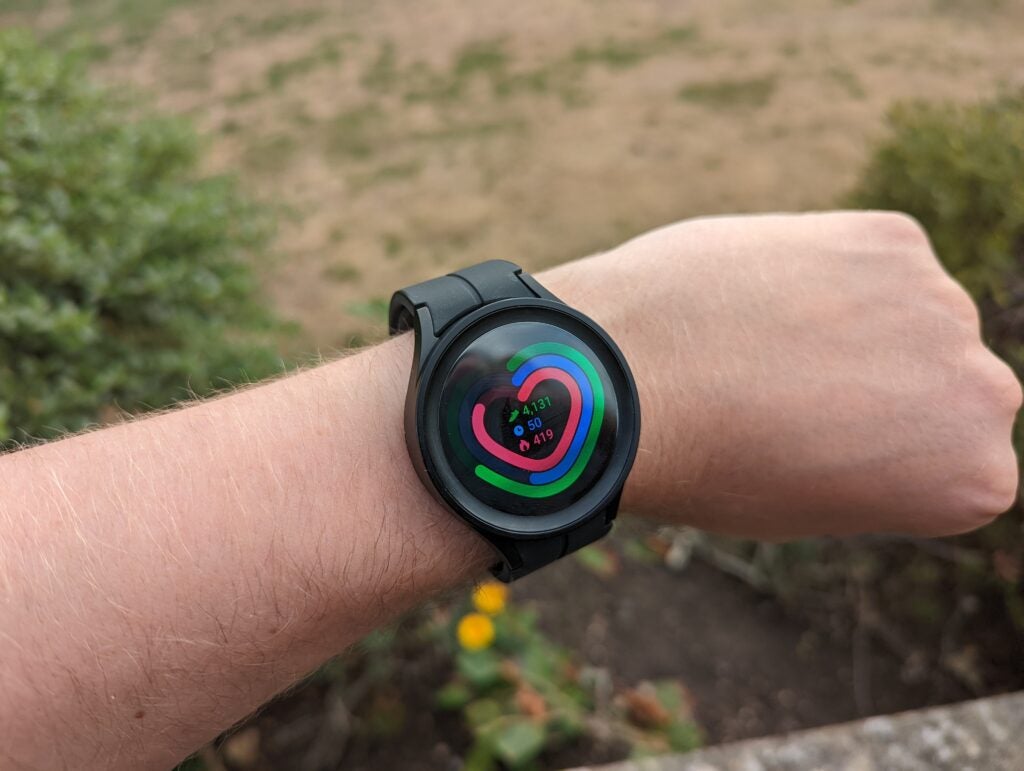
Samsung Galaxy Watch 5 Pro
The best Wear OS smartwatch
Pros
- Solid fitness tracking services
- Rugged, sports-ready design
- Wonderfully bright display
Cons
- Route planning process feels clunky
- Battery life doesn’t match rival fitness trackers
If you’re not an iPhone user but want a top-tier smartwatch that has plenty of apps, then your best bet is currently the Samsung Galaxy Watch 5 Pro. It might not quite hit the same heights as the Apple Watch 7 for its all-round capabilities, but right now it remains our pick of the bunch as far as Android-compatible smartwatches are concerned.
It’s got a highly robust design, including a titanium bezel and sapphire screen, along with IP68 impermeability and 5ATM water resistance. The Super AMOLED screen may lack a variable refresh rate but it’s brilliantly bright and packs excellent contrast, while it’s large enough that text and icons are shown off well too.
We found the health tracking options to be varied and useful, with the focus on sleep tracking being a particular highlight, and the onboard route navigation is a brilliant boon if you’re an outdoorsy adventurer (although can be finicky to put into place). Fitness tracking is generally accurate as well, though you may not get quite the same wealth of post-workout analytics as you would from a top-end Garmin.
Battery life tends to last 3-4 days of moderate use, which is decent for a smartwatch such as this, and the charge speeds (1 hour 22 minutes to full) are decent but not best-in-class.
Reviewer: Alastair Stevenson
Full Review: Samsung Galaxy Watch 5 Pro

Apple Watch Ultra 2
Best rugged smartwatch
Pros
- Top screen
- Excellent sports tracking
- The best Apple Watch
Cons
- Fitness tracking feels dated
- Lack of performance analysis
- Mapping rolling out slowly
Much like the Apple Watch 9, the Apple Watch Ultra 2 can really only be recommended to iPhone users (if you want an Android compatible rugged smartwatch then check out our best Garmin watch round-up). However, if you are tied into Apple’s ecosystem and you have the budget to accommodate this wearable’s admittedly high asking price then you won’t find anything better than the Apple Watch Ultra 2.
This beast of a smartwatch features a 49mm titanium case which makes it readily suited to take on the elements. It’s even designed to withstand high levels of water pressure so that freedivers can use the watch in depths of up to 40m.
It also boasts IP6X dust resistance so you can rest assured that the high asking price does as least come with the peace of mind in knowing that the Apple Watch Ultra 2 is an investment, designed to last well into the future.
This robust design is complemented by the large 1.91-inch OLED display that’s incredibly easy to read, particularly as it has an astounding peak brightness level of 3000nits which absolutely decimates the 1000nits peak brightness of the original Watch Ultra.
Because the Watch Ultra 2 is designed to go the distance, it also lasts for much longer on a single charge – up to 72-hours in fact. It’s certainly not as lengthy as what you’ll get from something like the Garmin Enduro 2 but as far as Apple Watches go, the extra longevity doesn’t go amiss.
Just like the Apple Watch Series 9, the Ultra 2 also boasts Double Tap to interact with the device, which can definitely help out if you’re on a long distance run and you don’t want to leave any sweat or smudge marks on the display.
Reviewer: James Stables
Full Review: Apple Watch Ultra 2

Coros Vertix 2
Best for battery life
Pros
- Great battery life
- Reliable sports tracking
- Added map support
Cons
- Music player doesn’t work with third-party apps
- Heavier than original Vertix
- Missing ANT+ support
As feature packed as smartwatches can be, there is a tendency for battery life to be their achilles heel. You’d be lucky to get more than two days of use out of the mainline watches from Apple and Samsung, but luckily the Coros Vertix 2 has no such problem.
If you want a smartwatch that can actually go the distance to the point where you’ll almost forget that it even needs to be charged then the Vertix 2 is your best option by a country mile. While the Garmin Enduro 2 can last for up to 33-days on a single charge, the Vertix 2 trumps that with a staggering 60-day battery life in smartwatch mode. Yes, you read that right – two whole months.
There are a few concessions that come with that long-standing battery life – the Vertix 2 uses a memory-in-pixel display which won’t look out of place to Garmin users but may seem like a step back to fans of the Apple Watch. Similarly, the Vertix 2 doesn’t lead the pack in terms of smart features, as there’s no digital assistant or third-party apps to bolster the wearable experience. What the Vertix 2 does excel in however (aside from battery life) is in fitness tracking.
The accompanying Coros app is a dream come true for enthusiasts and athletes who want to plan every aspect of their workout routine, down to the tiniest detail. The watch itself features high-end sensors to track everything from your heart rate to your HRV, the latter of which is crucial for monitoring your body’s post-workout recovery.
The Vertix 2 also offers excellent mapping support which, in conjunction with its dual-frequency GPS connectivity, makes it ideal for tracking outdoors runs and hikes. The one thing to bear in mind is that the Vertix 2 doesn’t come cheap with a price tag of £599/$699, but there’s no denying that when it comes to battery life, no other smartwatch comes close.
Reviewer: Michael Sawh
Full Review: Coros Vertix 2 review
FAQs
This depends on what you want to do with it. If you want a brilliant smartwatch that can do everything from local music to reliable, in-depth wellness and fitness tracking you’ll likely have to spend over $400/£400. If you just want a basic wearable to count your steps and push incoming notifications from your phone there are plenty of good options that retail for less than $200/£200.
LTE is useful if you use your watch a lot while away from your phone. But for most people, it’s not an essential purchase. The majority of users will always have their phone nearby and smartwatches can easily tether to them and share their data.
Apple is the biggest smartwatch maker in the world, but there are plenty of other smartwatch platforms. Google develops a competing Wear OS platform that’s used by most mainstream watchmakers, including the Fossil Group and Samsung. Fitness companies, like Garmin and Polar, also develop their own proprietary smartwatch software.
We also considered…
Comparison specs
You can see a full breakdown of all the smartwatches in this lists specifications in the table below. As you can see the main differences stem around the screen tech used, and features like GPS and battery life. Holistically the Apple Watch 7 is the most developed device in everything but battery life.



